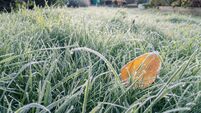Irish stargazers hopeful of spotting very rare 'green comet' tonight

Comet C/2022 E3 (ZTF), a rare green comet, last seen around 50,000 years ago, is due to make its closest pass by Earth on Wednesday night. Picture: Nasa
Irish stargazers will get a rare opportunity on Wednesday night with a ‘green comet’ set to be visible over earth for the first time since the Stone Age.
The comet, officially known as C/2022 E3 (ZTF), was discovered by astronomers in March 2022 at the Zwicky Transient Facility in California.
The glow being expelled from its head has led to the ‘green’ nickname
It is set to be most visible over Ireland both Wednesday night and Thursday evening, with the comet set to streak across the skies for the first time in 50,000 years.
MTU Blackrock Observatory's Rob O'Sullivan said the visibility of the comet will be determined by a number of factors.
"Even in ideal conditions you may struggle to see it without the assistance of at least a pair of binoculars," he explained.
"The main issue you need to overcome, after poor weather, is light pollution.
"Try to find a remote area beyond a town or city where artificial lights are not disturbing your view of the night sky."
While you might think the shiny moon may be a help, it's actually a hindrance.
Mr O'Sullivan said: "Believe it or not, the moon can actually make this task harder as well so it’s not ideal that it will be visible tomorrow. If you can head out between 12.30am and 1am, it’s probably the optimal window to try."

The comet is believed to have come from an area known as the Oort cloud — a theorised icy area at the very margins of our solar system.
He notes "It’s very far away. We’ve not been able to directly image an Oort cloud object."
Mr O'Sullivan noted that once a few days have passed, it'll be increasingly difficult to spot the comet without a telescope.
"If you miss it Wednesday you should definitely try again Thursday. Before long though you’ll be waiting 50,000 years for another opportunity."
There are a couple of things that hopeful stargazers can do to increase their chances of seeing the rare comet.
"Definitely grab a pair of binoculars if you can," Mr O'Sullivan urged.
"Even if the comet can technically be seen with the naked eye it is going to be much easier to see with some assistance. However the single most important thing you can do is get away from light pollution.
"Look to the North, near the North Star. If you can find the Big Dipper it can really assist you in doing this. There are a number of resources available online to help you find the North Star. Once you’ve done that you need to look out for something that looks a bit like a green smudge."
Met Éireann said that Wednesday night "will be mostly cloudy with patchy light rain or drizzle and some hill fog".
Meanwhile, Nasa plans to observe the comet with its James Webb Space Telescope (JWST), which could provide clues about the solar system's formation.
It said: “Comets are notoriously unpredictable, but if this one continues its current trend in brightness, it’ll be easy to spot with binoculars, and it’s just possible it could become visible to the unaided eye under dark skies.”









